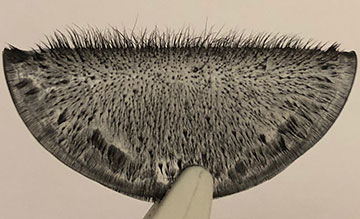
An array of magnetic cilia folded and held in the tip of tweezer. [Image: Jessica A.-C. Liu]
The field of “soft robotics” focuses on developing robots out of flexible, compliant materials, allowing for improved adaptability and safety. It’s a heavily biomimetic discipline, drawing inspiration from nature and the materials making up living organisms to advance soft materials and devices.
Now, researchers at two North Carolina, USA, universities have demonstrated shape-memory magnetic cilia, inspired by the hairlike structures lining human lungs, that can be programmed, shaped and then reconfigured with light and magnetic fields. The researchers believe their magnetic cilia and accompanying theoretical model could find a wide-range of applications, including in the design of soft robotics and microrobots (Adv. Mater. Technol., doi: 10.1002/admt.202000147).
The advantages of cilia
Cilia are hairlike organelles that line the lungs of humans and cover cell surfaces. These tiny, oblong structures assist in fluid and particle movement within the body, such as transporting inhaled particles out of the lungs, among other functions. Biologically speaking, cilia are considered to be so versatile and optimally evolved that scientists have designed artificial cilia and applied them to many different applications.
“Active surfaces that can be stimulated for transporting objects, including liquids, and control of wetting are important applications of magnetic cilia,” says first author Jessica A.-C. Liu, a recent Ph.D. graduate from North Carolina State University (NCSU). And they’ve already been demonstrated for pumping applications in microfluidics. “Another area of application of magnetic cilia is reconfigurable optics,” continues Liu, “where changing the orientation of the cilia alters their individual or collective optical properties.”
Typically, these artificial structures depend on a sustained magnetic field to keep their shape, returning to their original form once the field is turned off. The North Carolina team, comprising researchers from NCSU and Elon University, wanted to design artificial magnetic cilia that exhibited the shape memory effect, enabling the creation of structures whose shape can be set, locked, unlocked and reconfigured, says NCSU professor Joseph B. Tracy.
The simpler the better
To fabricate such an array, the researchers embedded magnetic iron microparticles in a matrix of thermoplastic polyurethane shape-memory polymers. In contrast to more complex, lengthy and expensive template-based approaches for fabricating magnetic cilia, the North Carolina researchers used a self-assembly approach for simplicity—crafting the material into artificial cilia via solvent casting within the vertical magnetic field between two permanent magnets.
Next, the team programmed the permanent shape of the cilia by clamping the structures into a bent shape between two glass slides and annealing at high temperature. The permanent shape is maintained unless it is reconfigured and annealed at a high temperature again.
The magnetic cilia depend on heat for actuation, so the researchers used an 860-nm-wavelength LED to photothermally heat the magnetic microparticles in the structures. The cilia are rigid and maintain their preset shape at room temperature, but after three minutes of illumination from the LED, the cilia soften, allowing for actuation from the magnet placed beneath the cilia array.
In experiments, after the cilia reoriented to a different shape, the researchers turned off the LED, allowed the array to cool, and locked the cilia in a temporary shape that was preserved even after removing the magnet. Switching the LED on again, with no magnet, snapped the array back to its permanent shape. Although, the researchers note, there were some limitations to shape recovery.
Magnetic torques and forces
The use of optical masks, according to Liu, allows the researchers to “obtain more complex structures” by optically controlling a subset of the cilia. The team demonstrated this experimentally by spatially controlling the actuation of the microstructures using a magnet and an optical mask—in this case, a piece of aluminum foil with a 5-mm slit.
In addition to these experiments, the team developed a theoretical model to better understand the forces at work and how the cilia could be designed for specific applications, as well as to predict the cilia’s response to actuation. One major revelation from the model, according to Elon professor Benjamin A. Evans, is that the magnetic torques from the applied magnetic fields are stronger and dominate the effects of magnetic forces in the artificial cilia.
Essentially, the high aspect ratio and small dimensions of the cilia cause them to rotate and align with the field from the magnet, rather than being pulled toward the magnet. This is significant, says Liu, as it answers “fundamental questions about the roles of torques and forces in magnetic cilia.”
As for future applications of the team’s research, says Liu, “Our models will be useful not only for designing cilia for specific applications, but also for the design of magnetically actuated microrobots.”
